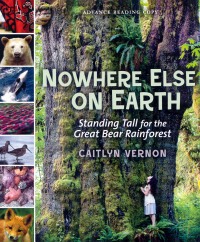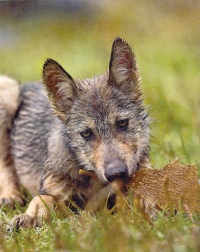| ________________
CM . . . . Volume XVIII Number 11 . . . . November 11, 2011

 |
Nowhere Else on Earth: Standing Tall for the Great Bear Rainforest.
Caitlyn Vernon.
Victoria, BC: Orca, 2011.
136 pp., pbk., $22.95.
ISBN 978-1-55469-303-0.
Subject Headings:
Great Bear Rainforest(B.C.)-Juvenile literature.
Rain forest ecology-British Columbia-Juvenile literature.
Indians of North America-British Columbia-Juvenile literature.
Grades 5-9 / Ages 10-14.
Review by Gillian Richardson.
***1/2 /4
Reviewed from Advance Reading Copy.
|
| |
|

excerpt:
If you live in a place where all the old-growth forests have been logged, you might think that trees don’t get very big. Or if the trees around you are less than one or two hundred years old, you might think that is as tall and wide as they get. To know what healthy ecosystems used to look like, and to measure the changes that have occurred, we need to find and learn about existing old-growth forests. We need to look as far back as possible and listen to the stories of how things used to be. Only from knowing the past can we assess what actions need to be taken today to protect or restore ecosystems.
What are the stories from the Great Bear Rainforest? What did it used to be like compared to what it’s like now? What has been harvested from the forest and the surrounding ocean? What is still there?
With a background in biology and environmental studies, author and environmental activist Caitlyn Vernon is well qualified to present her call for action to defend the Great Bear Rainforest on BC’s Pacific Coast. The “Introduction” to Nowhere Else on Earth starkly describes two reasons to stand up and be counted if we value such wild places—the salmon and bears are losing their habitat, and new attitudes are needed to reverse the loss.

The first few chapters paint a detailed picture of the setting, the coastal temperate rainforest that encompasses much of BC’s coast. Readers will meet the animals and plants of the land and sea, as well as the First Nations people who live at the water’s edge. Readers will also learn how all of these animal and human lives have always been interconnected. One chapter describes the changes that can be documented: decline in numbers of salmon, eulachon, abalone, whales, sea otters, grizzlies and old growth trees. More detailed accounts are included about logging and the decline of salmon stocks. If there are unknowns as yet about the salmon story, the author feels the same is not true for the trees of the rainforest, and she describes the 1990s campaign to save the Great Bear Rainforest. Besides the issue of logging, factors such as climate change brought about by use of fossil fuel are discussed in light of the statement, “We can choose what future we want to live in.” The final chapter outlines ways to “get informed, get inspired, make choices and get involved”. A list of 25 practical ideas (easily available to a concerned young citizen) for action is included. A helpful Glossary will clarify vocabulary highlighted throughout the text. Further Reading selections in print and online are offered. An Index will be included in the final, finished version.
The main chapter content is detailed and presented in a highly readable style. The book is loaded with extras. Sidebars provide “Take Action” tips and “Did You Know” answers to questions such as, “Are the bears the real problem?” and “How much does it rain in BC’s coastal temperate rainforest?” In Eco-Story boxes, the author shares personal observations from her childhood at the coast and from her university studies. ‘Voices From the Coast’ inserts introduce First Nations elders and young people, biologists, activists, a forestry worker, all of whom have had an intimate relationship with the ecosystem. Inspirational quotes are liberally scattered throughout the book. They represent voices from the past (Harriet Tubman, Gandhi, Einstein, Helen Keller) as well as the present (activists, authors, scientists). Current and historical photographs enhance the information. The book is printed on non-glossy, 100% post-consumer recycled and ancient–forest friendly paper.
The author’s passion for her topic is clearly evident in the depth of research and detail presented here. Few questions go unanswered or, at least, solutions are suggested. The reader is urged to consider both economic and environmental needs with respect to demands on the ecosystems. Emotions do creep into the text but are used effectively to appeal to our basic instincts: “Standing next to an ancient tree is a humbling experience. To touch its bark and think that this tree has been alive for over a thousand years…was ancient when Canada was formed as a country and is still standing today…” Vernon’s case against open-net fish farms is factual, but she encourages readers to make an educated decision of their own. Foremost here is the objective to advocate for change in the face of serious environmental issues (represented by the Great Bear Rainforest) that affect us all, and in that goal, the author has achieved success. Readers who finish Nowhere Else on Earth will be well informed and motivated to discuss and perhaps plan future actions of their own. Nowhere Else on Earth is a valuable book for the times, giving insight into past, present and possible futures for the Earth.
Highly Recommended.
Gillian Richardson is a freelance writer living in BC.

To comment
on this title or this review, send mail to cm@umanitoba.ca.
Copyright © the Manitoba Library Association. Reproduction for personal
use is permitted only if this copyright notice is maintained. Any
other reproduction is prohibited without permission.
NEXT REVIEW |
TABLE OF CONTENTS FOR THIS ISSUE
- November 11, 2011.
AUTHORS |
TITLES |
MEDIA REVIEWS |
PROFILES |
BACK ISSUES |
SEARCH |
CMARCHIVE |
HOME |

